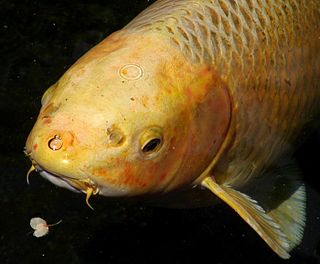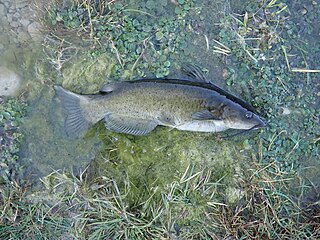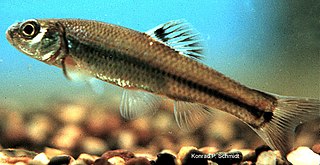
The flathead catfish, also called by several common names including mudcat or shovelhead cat, is a large species of North American freshwater catfish in the family Ictaluridae. It is the only species of the genus Pylodictis. Ranging from the lower Great Lakes region to northern Mexico, it has been widely introduced and is an invasive species in some areas. The closest living relative of the flathead catfish is the much smaller widemouth blindcat, Satan eurystomus.

The iridescent shark,iridescent shark catfish is a species of shark catfish native to the rivers of Southeast Asia. Despite its name, it is not a shark. It is found in the Mekong basin as well as the Chao Phraya River, and is heavily cultivated for food there.

The Ictaluridae, sometimes called ictalurids, are a family of catfish native to North America, where they are an important food source and sometimes fished for sport. The family includes about 51 species, some commonly known as bullheads, madtoms, channel catfish, and blue catfish.

The brown bullhead is a fish of the family Ictaluridae that is widely distributed in North America. It is a species of bullhead catfish and is similar to the black bullhead and yellow bullhead. It was originally described as Pimelodus nebulosus by Charles Alexandre Lesueur in 1819, and is also referred to as Ictalurus nebulosus.

The channel catfish is North America's most numerous catfish species. It is the official fish of Kansas, Missouri, Nebraska, and Tennessee, and is informally referred to as a "channel cat". In the United States, they are the most fished catfish species with around 8 million anglers targeting them per year. They also have very few teeth and swallow food whole. The popularity of channel catfish for food has contributed to the rapid expansion of aquaculture of this species in the United States. It has also been widely introduced in Europe, Asia and South America, and it is legally considered an invasive species in many countries.

The blue catfish is a large species of North American catfish, reaching a length of 65 in (170 cm) and a weight of 165 lb (75 kg). The continent’s largest, it can live to 20 years, with a typical fish being between 25–46 in (64–117 cm) and 30–70 lb (14–32 kg). Native distribution is primarily in the Mississippi River and Louisiana drainage systems, including the Missouri, Ohio, Tennessee, and Arkansas Rivers, the Des Moines River in south-central Iowa, the Rio Grande, and south along the Gulf Coast to Belize and Guatemala.

The yellow bullhead is a species of bullhead catfish, a ray-finned fish that lacks scales.

In fish anatomy and turtle anatomy, a barbel is a slender, whiskerlike sensory organ near the mouth. Fish that have barbels include the catfish, the carp, the goatfish, the hagfish, the sturgeon, the zebrafish, the black dragonfish and some species of shark such as the sawshark. Barbels house the taste buds of such fish and are used to search for food in murky water.

The Mexican big-eared bat is a species of vesper bat endemic to Mexico. They are nocturnal and insectivorous. Their very large ears are located across their foreheads, and when captured, the bats are observed to curl their ears in a protective manner. The adults are usually brown colored, while the juveniles are usually a smokey brown color. They have small noses.

Ictalurus is a genus of North American freshwater catfishes. It includes the well-known channel catfish and blue catfish.
Barton's cichlid is a species of cichlid endemic to freshwater springs in the upper Panuco River basin of San Luis Potosí, Mexico.
Ictalurus australis, the Panuco catfish, is a species of North American freshwater catfish, endemic to the Panuco River basin in Mexico.

Ictalurus lupus is a species of catfish in the family Ictaluridae. It resembles the closely related channel catfish, but is smaller, lacks spots, and has a caudal fin with a shallower fork, and grows to a total length of 48 cm (19 in). It is found in Northeastern Mexico and the Southwestern United States.

Ictalurus pricei, the Yaqui catfish, is a species of North American freshwater catfish native to Mexico and Arizona.

The tropical royal flycatcher is a passerine bird that the International Ornithological Committee (IOC) places in the family Tityridae. It is found in Mexico, south through most of Central America, and in every mainland South American country except Argentina, Chile, Paraguay, and Uruguay.

Cavefish or cave fish is a generic term for fresh and brackish water fish adapted to life in caves and other underground habitats. Related terms are subterranean fish, troglomorphic fish, troglobitic fish, stygobitic fish, phreatic fish, and hypogean fish.

The white bullhead, also known as the white catfish, is a member of the family Ictaluridae of the order Siluriformes.

The bullhead minnow is a species of freshwater demersal fish, native to the Mississippi River system in the United States, to tributaries of Lake Huron and Lake Michigan and to northern Mexico.

Ameiurus platycephalus, the flat bullhead, is a species of North American freshwater catfish native to the waters of the southeastern United States from Virginia to Georgia. This species grows to a maximum length of 29 cm (11 in) TL though it is more commonly about 23 cm (9 in) long.
Ictalurid herpesvirus 2 (IcHV-2) is a species of virus in the genus Ictalurivirus, family Alloherpesviridae, and order Herpesvirales.















